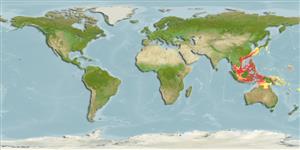>
Anguilliformes (Eels and morays) >
Congridae (Conger and garden eels) > Bathymyrinae
Etymology: Ariosoma: Greek, ari = very, strength, superiority + Greek, soma = body (Ref. 45335).
More on author: Fowler.
Environment: milieu / climate zone / profondeur / distribution range
Écologie
marin démersal; profondeur ? - 717 m (Ref. 280). Tropical
Western Central Pacific.
Taille / Poids / Âge
Maturité: Lm ? range ? - ? cm
Max length : 20.8 cm TL mâle / non sexé; (Ref. 123550)
Description synthétique
Clés d'identification | Morphologie | Morphométrie
Life cycle and mating behavior
Maturité | Reproduction | Frai | Œufs | Fécondité | Larves
Smith, D.G., 1999. Congridae. Conger eels. p. 1680-1686. In K.E. Carpenter and V.H. Niem (eds.) FAO species identification guide for fishery purposes. The living marine resources of the WCP. Vol. 3. Batoid fishes, chimaeras and bony fishes part 1 (Elopidae to Linophrynidae). FAO, Rome. (Ref. 11039)
Statut dans la liste rouge de l'IUCN (Ref. 130435: Version 2025-1)
Menace pour l'homme
Harmless
Utilisations par l'homme
Pêcheries: sans intérêt
Outils
Articles particuliers
Télécharger en XML
Sources Internet
Estimates based on models
Preferred temperature (Réf.
123201): 12.1 - 26.5, mean 19.3 °C (based on 233 cells).
Phylogenetic diversity index (Réf.
82804): PD
50 = 0.5000 [Uniqueness, from 0.5 = low to 2.0 = high].
Bayesian length-weight: a=0.00115 (0.00048 - 0.00277), b=3.06 (2.85 - 3.27), in cm total length, based on LWR estimates for this (Sub)family-body shape (Ref.
93245).
Niveau trophique (Réf.
69278): 3.7 ±0.6 se; based on size and trophs of closest relatives
Résilience (Réf.
120179): Haut, temps minimum de doublement de population inférieur à 15 mois (Preliminary K or Fecundity.).
Fishing Vulnerability (Ref.
59153): Low vulnerability (11 of 100).
🛈
